The EU banana flour industry is projected to grow from USD 1,500 million in 2025 to USD 2,055.4 million by 2035, advancing at a CAGR of 3.2%. The sun-dried segment is expected to lead sales with a 40% share in 2025, while the food industry application is anticipated to account for 30% of the application segment.
European Union banana flour sales are projected to grow from USD 1,500 million in 2025 to approximately USD 2,055.4 million by 2035, recording an absolute increase of USD 546.4 million over the forecast period. This translates into total growth of 36.4%, with demand forecast to expand at a compound annual growth rate (CAGR) of 3.2% between 2025 and 2035. The overall industry size is expected to grow by nearly 1.4X during the same period, supported by the increasing shift toward gluten-free alternatives, growing awareness of resistant starch benefits, and developing applications across bakery, snack, and beverage formulations throughout European retail and foodservice channels.
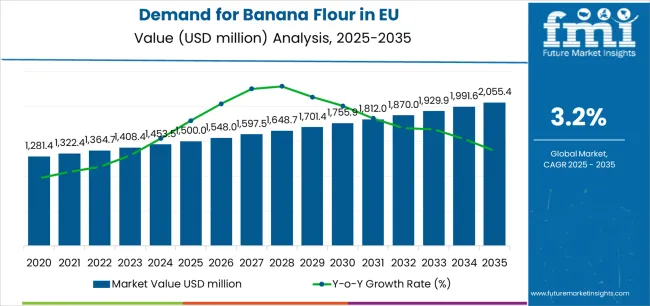
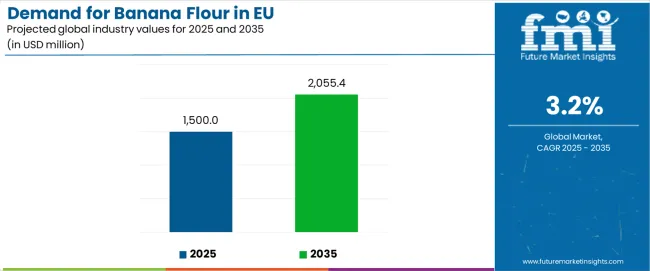
| Metric | Value |
|---|---|
| Market Value (2025) | USD 1,500 million |
| Market Forecast Value (2035) | USD 2,055.4 million |
| Forecast CAGR (2025 to 2035) | 3.2% |
Between 2025 and 2030, EU banana flour demand is projected to expand from USD 1,500 million to USD 1,749.8 million, resulting in a value increase of USD 249.8 million, which represents 45.7% of the total forecast growth for the decade. This phase of development will be shaped by rising consumer adoption of gluten-free alternatives, increasing availability of diverse product varieties across sun-dried, freeze-dried, and spray-dried banana flour types, and growing mainstream acceptance of banana flour across retail and foodservice channels. Manufacturers are expanding their product portfolios to address the evolving preferences for improved taste profiles, versatile baking applications, and nutritionally fortified formulations comparable to conventional wheat flour alternatives.
From 2030 to 2035, sales are forecast to grow from USD 1,749.8 million to USD 2,055.4 million, adding another USD 296.6 million, which constitutes 54.3% of the overall ten-year expansion. This period is expected to be characterized by further expansion of organic and premium varieties, integration of advanced processing techniques for enhanced digestive health benefits, and development of innovative application formats targeting diverse consumer preferences. The growing emphasis on clean-label formulations and increasing consumer willingness to pay premium prices for gut-health supporting alternatives will drive demand for high-quality banana flour products that deliver authentic baking performance with superior nutritional profiles including resistant starch content.
Between 2020 and 2025, EU banana flour sales experienced steady expansion at a CAGR of 2.2%, growing from USD 1,345.4 million to USD 1,500 million. This period was driven by increasing health consciousness among European consumers, rising awareness of gluten-free diets and celiac disease, and growing recognition of banana flour's resistant starch benefits. The industry developed as major food companies and specialized gluten-free brands recognized the commercial potential of banana-based flour alternatives. Product innovations, improved drying techniques, and taste profile enhancements began establishing consumer confidence and mainstream acceptance of banana flour products.
Industry expansion is being supported by the rapid increase in gluten-intolerant and health-conscious consumers across European countries and the corresponding demand for nutritious, versatile, and functionally effective grain-free alternatives with proven functionality in baking and cooking applications. Modern consumers rely on banana flour as a direct replacement for wheat flour in baking routines, healthy snacking, smoothie preparation, and culinary applications, driving demand for products that match or exceed conventional flour's functional properties, including binding capacity, moisture retention, and neutral flavor profile. Even minor dietary concerns, such as gluten sensitivity, digestive discomfort, or blood sugar management, can drive comprehensive adoption of banana flour to maintain optimal wellness and support comfortable digestion.
The growing awareness of resistant starch nutrition and increasing recognition of banana flour's digestive health benefits are driving demand for banana flour alternatives from certified producers with appropriate quality credentials and processing transparency. Regulatory authorities are increasingly establishing clear guidelines for banana flour labeling, gluten-free certification standards, and quality requirements to maintain consumer safety and ensure product consistency. Scientific research studies and nutritional analyses are providing evidence supporting banana flour's prebiotic benefits and functional advantages, requiring specialized drying methods and standardized production protocols for authentic taste development, optimal resistant starch preservation, and appropriate nutritional profiles, including potassium content and dietary fiber levels.
Sales are segmented by product type (process), application, distribution channel, nature (source), and country. By product type, demand is divided into sun-dried, freeze-dried, spray-dried, and others formats. Based on application, sales are categorized into food industry, bakery & snacks, beverages, infant foods, soups & sauces, filling & dressings, pet food & feed, and household varieties. In terms of distribution channel, demand is segmented into direct sales, modern trade, specialty store, convenience store, e-retailers, and others. By nature, sales are classified into organic and conventional. Regionally, demand is focused on Germany, France, Italy, Spain, the Netherlands, and the Rest of Europe.
.webp)
The sun-dried segment is projected to account for 40% of EU banana flour sales in 2025, declining to 35% by 2035, maintaining its position as the leading processing format across European consumers. This commanding position is fundamentally supported by sun-dried banana flour's traditional processing heritage, comprehensive cost-effectiveness from natural drying methods, and superior resistant starch retention enabling authentic digestive health benefits. The sun-dried format delivers exceptional nutritional appeal, providing manufacturers with a processing method that facilitates natural production, sustainable operations, and clean-label positioning essential for category growth.
This segment benefits from mature production infrastructure, well-established tropical sourcing networks, and extensive variety from multiple banana flour producers who maintain rigorous quality standards and continuous innovation. Additionally, sun-dried banana flour offers versatility across various applications, including gluten-free baking, smoothie powders, baby food formulations, and paleo-diet products, supported by proven processing technologies that address traditional challenges in moisture control and enzymatic browning prevention.
The sun-dried segment is expected to maintain its leading position through 2035, though its share declines to 35% as spray-dried formats gain market share due to standardization advantages and processing efficiency, demonstrating the category's evolution toward more controlled manufacturing processes throughout the forecast period.
Key advantages:
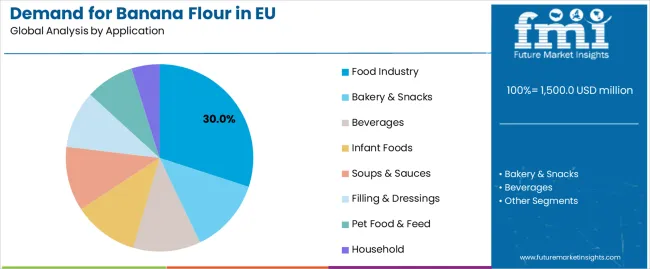
Food industry applications are positioned to represent 30% of total banana flour demand across European operations in 2025, declining to 27% by 2035, reflecting the segment's established role as the primary commercial application within the overall category. This considerable share directly demonstrates that food manufacturing represents the dominant use case, with processors utilizing banana flour for gluten-free product formulation, texture modification, nutritional fortification, and clean-label declarations across diverse food manufacturing operations.
Modern food processors increasingly view banana flour as an essential functional ingredient for gluten-free product development, driving demand for flour optimized for processing stability with appropriate moisture absorption characteristics, standardized particle size distribution that supports consistent manufacturing, and neutral flavor profiles that deliver authentic taste experiences resonating across consumer demographics. The segment benefits from continuous innovation focused on specialized flour grades, customized granulation specifications, and technical application support enhancing manufacturing efficiency.
The segment's declining share reflects faster expansion in consumer-facing applications such as bakery & snacks and beverages, which grow from 20% to 22% and 15% to 16% respectively, as household baking and ready-to-eat products increasingly feature banana flour throughout the forecast period.
Key drivers:
Modern trade channels are strategically estimated to control 25% of total European banana flour sales in 2025, declining to 22% by 2035, reflecting the channel's established importance for mainstream consumer accessibility and brand visibility. European retail operators consistently demonstrate growing shelf space allocation for banana flour that delivers convenient access, competitive pricing, and reliable quality across mainstream supermarkets and hypermarkets.
The segment provides essential consumer touchpoints through widespread availability, promotional support driving category awareness, and placement strategies in gluten-free sections and baking aisles where visibility optimizes discovery and cross-shopping. Major European retailers, including Tesco, Carrefour, Rewe, Albert Heijn, and Mercadona, systematically expand banana flour selections, often featuring private-label offerings, organic varieties, and premium brands that normalize gluten-free flour consumption and drive household trial.
The segment's declining share reflects the rapidly growing e-retailers channel, which expands from 20% in 2025 to 26% in 2035, as consumers increasingly purchase specialty flours through online platforms offering broader selection, detailed product information, and convenient home delivery throughout the forecast period.
Success factors:
Conventional banana flour products are strategically positioned to contribute 65% of total European sales in 2025, declining to 55% by 2035, representing products produced through standard banana processing without organic certification requirements. These conventional products successfully deliver accessible pricing and consistent quality while ensuring broad commercial availability across all distribution channels that prioritize volume scalability and cost competitiveness over organic certification.
Conventional production serves price-conscious consumers, mainstream food manufacturing applications, and value-oriented households that require affordable gluten-free options at competitive price points compared to specialty grain-free flours. The segment derives significant competitive advantages from established banana supply chains, economies of scale in production, and the ability to meet substantial volume requirements from major food manufacturers without organic certification constraints limiting raw material sourcing options.
The segment's declining share through 2035 reflects the category's evolution toward premium organic products, which grow from 35% in 2025 to 45% in 2035, as health-conscious consumers and clean-label manufacturers increasingly prioritize organic certification and sustainable banana sourcing.
Competitive advantages:
EU banana flour sales are advancing steadily due to increasing gluten-free diet adoption, growing resistant starch awareness, and rising health consciousness regarding digestive wellness. The industry faces challenges, including persistent taste considerations for traditional bakers accustomed to wheat flour, higher price points compared to conventional flours that limit mass adoption, and banana supply chain vulnerabilities affecting raw material availability. Continued innovation in processing technologies and recipe development remains central to industry development.
The rapidly accelerating understanding of resistant starch benefits is fundamentally transforming banana flour from simple gluten-free alternative to functional health ingredient, enabling digestive wellness positioning previously unattainable through conventional grain-free flours alone. Advanced nutritional research demonstrating resistant starch's prebiotic properties, blood sugar regulation benefits, and gut microbiome support allows manufacturers to position banana flour products with 10-15 grams resistant starch per serving, proven digestive benefits, and genuine functional wellness comparable to specialized prebiotic supplements. These health innovations prove particularly transformative for wellness-focused consumers, including diabetic individuals, weight management seekers, and gut-health conscious households, where resistant starch content proves essential for product selection.
Major banana flour brands invest heavily in clinical research partnerships, digestive health messaging development, and nutritional education for health-conscious formulations, recognizing that resistant starch varieties represent breakthrough solutions for functional positioning challenges limiting premium category expansion. Manufacturers collaborate with nutritionists, gastroenterologists, and wellness influencers to develop evidence-based communications that emphasize digestive benefits while maintaining taste acceptability and versatile functionality supporting mainstream positioning.
Modern banana flour producers systematically optimize green banana sourcing, enzymatic activity management, and drying protocols that maximize resistant starch preservation, minimize enzymatic browning, and deliver consistent flour functionality comparable to established grain-free alternatives. Strategic integration of processing controls optimized for green banana maturity enables manufacturers to position banana flour as legitimate functional ingredients where resistant starch levels directly determine health-conscious consumer purchasing behavior. These processing improvements prove essential for premium retail positioning, as quality-focused consumers demand resistant starch verification, processing transparency, and scientific validation supporting digestive health claims.
Companies implement extensive supplier quality programs, maturity assessment protocols, and processing optimization targeting functional consistency, including resistant starch content preservation, color stability during storage, and moisture content standardization throughout distribution. Manufacturers leverage green banana positioning in marketing campaigns, on-pack communication featuring "high resistant starch," and health benefit messaging, positioning premium banana flour as functional alternatives delivering measurable wellness benefits.
European food manufacturers and home bakers increasingly prioritize innovative banana flour applications featuring optimized baking recipes, blended flour systems, and functional formulations that differentiate premium offerings through performance advantages and taste improvement. This application innovation trend enables producers to drive category expansion through usage versatility, premium pricing through specialized flour blends, and market differentiation resonating with gluten-free consumers seeking wheat flour alternatives without taste compromise. Application innovation proves particularly important for bakery categories where texture and rise performance drive flour selection and baking success.
The development of sophisticated flour blend systems, including banana-almond combinations, banana-cassava formulations, and fortified banana flour varieties expands manufacturers' abilities to create versatile products delivering optimal baking performance without specialized techniques. Brands collaborate with baking experts, recipe developers, and gluten-free chefs to develop formulations balancing functional performance with familiar taste profiles, supporting premium positioning and repeat purchase while maintaining nutritional credentials across health-conscious consumer segments.
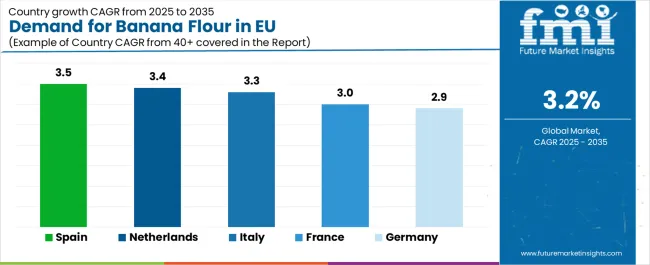
| Country | CAGR % (2025-2035) |
|---|---|
| Spain | 3.5% |
| Netherlands | 3.4% |
| Italy | 3.3% |
| France | 3% |
| Germany | 2.9% |
EU banana flour sales demonstrate solid growth across major European economies, with Spain leading expansion at 3.5% CAGR through 2035, driven by strong health consciousness and gluten-free market development. Netherlands shows robust growth at 3.4% CAGR through innovation adoption and specialty retail expansion. Italy maintains 3.3% CAGR, benefiting from high celiac disease awareness and medical community support. Rest of Europe records 3.2% CAGR reflecting diverse smaller operations. France demonstrates 3% CAGR with steady gluten-free acceptance. Germany shows 2.9% CAGR reflecting established market maturity. Overall, sales show consistent regional development reflecting EU-wide dietary shifts toward gluten-free alternatives and banana flour acceptance.
Revenue from banana flour in Germany is projected to exhibit steady growth with a CAGR of 2.9% through 2035, driven by exceptionally well-developed gluten-free product infrastructure, comprehensive retail availability for grain-free alternatives, and strong consumer commitment to health-conscious dietary choices throughout the country. Germany's sophisticated understanding of celiac disease management and internationally recognized leadership in gluten-free product adoption are creating substantial demand for diverse banana flour varieties across all consumer segments.
Major retailers, including Edeka, Rewe, Aldi, and specialized organic chains such as Alnatura, denn's Biomarkt, and Bio Company, systematically expand banana flour selections, often dedicating extensive shelf space to gluten-free alternatives and positioning them prominently to encourage trial. German demand benefits from high celiac disease diagnosis rates, substantial disposable income supporting premium organic products, and cultural openness to dietary alternatives that naturally supports banana flour adoption across mainstream consumers beyond core celiac demographics.
Growth drivers:
Revenue from banana flour in France is expanding at a CAGR of 3%, supported by evolving consumer attitudes toward gluten-free alternatives despite France's strong traditional wheat-based culinary culture and baking heritage. France's growing health consciousness among younger urban consumers and increasing celiac disease awareness are gradually driving demand for quality banana flour alternatives across diverse demographic segments.
Major retailers, including Carrefour, Auchan, Leclerc, and specialized organic chains including Naturalia and Biocoop, gradually establish comprehensive banana flour ranges to serve continuously growing demand. French sales particularly benefit from sophisticated taste standards demanding superior quality, driving product innovation and premiumization within the banana flour category. Nutritionist recommendations and medical endorsements significantly enhance penetration rates despite historical preference for wheat flour in traditionally bread-centric food culture.
Success factors:
Revenue from banana flour in Italy is growing at a robust CAGR of 3.3%, fundamentally driven by exceptionally high celiac disease diagnosis rates, progressive medical community support, and comprehensive government programs supporting gluten-free dietary management. Italy's traditionally wheat-rich diet is rapidly accommodating gluten-free options as consumers recognize health benefits and digestive advantages of eliminating gluten while maintaining nutritional balance through alternative flours.
Major retailers, including Coop Italia, Esselunga, Conad, and Carrefour Italia, strategically invest in banana flour category expansion and consumer education programs to address growing interest in grain-free alternatives. Italian sales particularly benefit from medical community endorsement, creating natural adoption among diagnosed celiac patients, combined with government reimbursement programs for gluten-free products in Milan, Rome, and throughout the country contributing to expansion through healthcare-driven purchasing.
Development factors:
Demand for banana flour in Spain is projected to grow at a CAGR of 3.5%, substantially supported by growing health consciousness among younger Spanish consumers, expanding retail availability through major supermarket chains, and increasing awareness of gluten sensitivity and celiac disease. Spanish consumer interest in wellness and natural nutrition positions banana flour as aligned with health-focused dietary evolution.
Major retailers, including Mercadona, Carrefour España, Alcampo, and Lidl España, systematically expand banana flour offerings, with Mercadona's private-label gluten-free products proving particularly successful in driving mainstream adoption through accessible pricing and prominent placement. Spain's growing wellness culture supports banana flour trial among health-conscious consumers seeking digestive comfort and grain-free nutrition.
Growth enablers:
Demand for banana flour in the Netherlands is expanding at a leading CAGR of 3.4%, fundamentally driven by exceptionally strong health food culture, leadership in specialty diet adoption, and comprehensive retail support for alternative flours across mainstream and specialized channels. Dutch consumers demonstrate particularly high receptivity to functional food messaging and willingness to adopt grain-free alternatives for health and digestive wellness reasons.
Netherlands sales significantly benefit from well-developed specialty retail infrastructure, including Albert Heijn's extensive gluten-free sections, Ekoplaza's specialized organic stores, and innovative health food startups testing new products in a receptive Dutch environment. The country's progressive consumer culture supports experimental dietary approaches, with banana flour positioned as premium functional ingredient rather than medical necessity. The Netherlands also serves as innovation testing ground for European gluten-free categories, with successful Dutch product launches often expanding to broader European operations.
Innovation drivers:
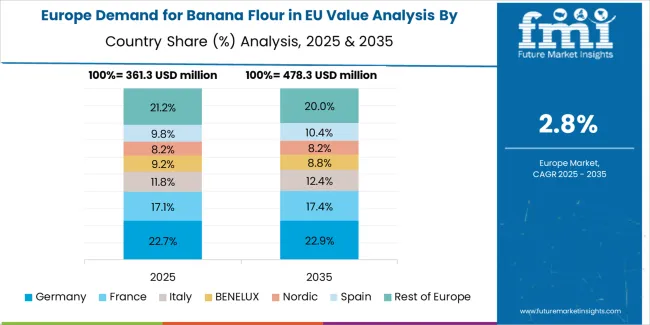
EU banana flour sales are projected to grow from USD 1,500 million in 2025 to USD 2,055.4 million by 2035, registering a CAGR of 3.2% over the forecast period. Spain is expected to demonstrate the strongest growth trajectory with a 3.5% CAGR, supported by strong gluten-free awareness, established health food culture, and retail innovation. Italy follows with a 3.3% CAGR, attributed to growing celiac disease diagnosis and expanding gluten-free product availability.
Germany maintains the largest share at 25% in 2025, driven by established gluten-free market infrastructure and health-conscious consumers, while growing at a 2.9% CAGR. The Netherlands demonstrates a 3.4% CAGR reflecting innovation leadership, while France records 3% CAGR. The rest of Europe shows a 3.2% CAGR, reflecting diverse regional development stages.
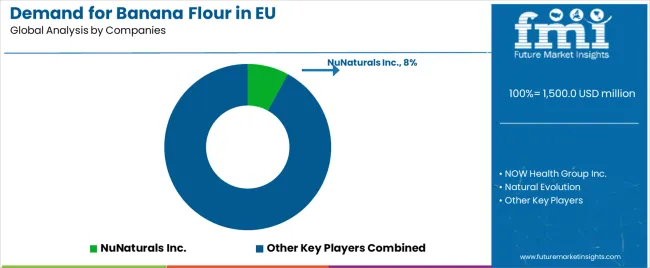
EU banana flour sales are defined by competition among specialized tropical ingredient suppliers, gluten-free food companies, and alternative flour producers. Companies are investing in green banana sourcing, processing optimization, resistant starch preservation, and application development to deliver high-quality, nutritionally superior, and functionally versatile banana flour solutions. Strategic partnerships with gluten-free food manufacturers, distribution expansion initiatives, and marketing campaigns emphasizing digestive health benefits and baking versatility are central to strengthening competitive position.
NuNaturals Inc. holds an estimated 8% share, leveraging its natural ingredient expertise, distribution networks, and established European presence through specialized health food channels. NuNaturals benefits from comprehensive quality systems, technical application knowledge, and ability to position banana flour alongside complementary natural sweeteners and supplements, supporting premium acceptance and specialty retail prominence.
NOW Health Group Inc. accounts for approximately 7% share, emphasizing diverse natural products portfolio across multiple categories, strong North American capabilities expanding to Europe through e-commerce platforms, and quality expertise supporting product development. NOW Health Group's success in developing quality natural ingredients with transparent sourcing creates strong positioning and consumer acceptance, supported by marketing capabilities and brand building expertise targeting health-conscious demographics.
Natural Evolution represents roughly 5% share through its position as organic banana flour specialist with quality-focused processing capabilities, providing organically certified banana flour products through sustainable tropical sourcing. The company benefits from organic certification expertise, fair-trade positioning, and clean-label communication helping health food retailers and consumers understand resistant starch benefits, supporting premium positioning and wellness-focused marketing.
Ceres Enterprises Ltd holds approximately 5% share, supporting growth through private-label manufacturing expertise, flexible production capabilities, and cost-competitive positioning across retail operations. Ceres leverages manufacturing efficiency, quality consistency, and rapid response capabilities serving major European retailers developing house-brand gluten-free offerings, attracting volume-focused retail partnerships seeking reliable banana flour suppliers with competitive economics.
KADAC Pty Ltd accounts for roughly 4% share through specialty channel positioning, health food store relationships, and quality-focused product portfolio emphasizing resistant starch content and digestive wellness positioning. The company benefits from established distribution in natural food channels, technical support for specialty retailers, and educational marketing supporting banana flour trial among health-conscious consumers.
Zuvii represents approximately 3% share, focusing on gluten-free niche positioning, allergen-free manufacturing facilities, and specialized product development for celiac and food allergy communities. Zuvii leverages dedicated production infrastructure ensuring zero cross-contamination, rigorous testing protocols, and allergen-free certification attracting consumers requiring strict gluten-free compliance and allergen safety.
Other companies collectively hold 68% share, reflecting competitive dynamics within European banana flour sales, where numerous regional tropical ingredient suppliers, emerging gluten-free brands, private-label manufacturers for major retailers, and specialized organic producers serve specific consumer preferences, local operations, and niche applications. This competitive environment provides opportunities for differentiation through specialized processing methods (freeze-dried, drum-dried), innovative flour blends (banana-coconut, banana-cassava), unique quality attributes (extra resistant starch, ultra-fine milling), and premium positioning resonating with health-conscious consumers seeking authentic gluten-free alternatives with proven digestive benefits.
| Item | Value |
|---|---|
| Quantitative Units | USD 2,055.4 million |
| Product Type (Process) | Sun-dried, Freeze-dried, Spray-dried, Others |
| Application | Food Industry, Bakery & Snacks, Beverages, Infant Foods, Soups & Sauces, Filling & Dressings, Pet Food & Feed, Household |
| Distribution Channel | Direct Sales, Modern Trade, Specialty Store, Convenience Store, E-Retailers, Others |
| Nature (Source) | Organic, Conventional |
| Countries Covered | Germany, France, Italy, Spain, the Netherlands, and the Rest of Europe |
| Key Companies Profiled | NuNaturals Inc., NOW Health Group Inc., Natural Evolution, Ceres Enterprises Ltd, KADAC Pty Ltd, Zuvii, Specialized brands |
| Additional Attributes | Dollar sales by product type (process), application, distribution channel, and nature; regional demand trends across major European economies; competitive landscape analysis with established ingredient suppliers and specialized gluten-free brands; consumer preferences for various banana flour processing methods and applications; integration with resistant starch preservation technologies and green banana sourcing optimization; innovations in flour blend development and baking performance enhancement; adoption across food manufacturing and household baking channels; regulatory framework analysis for gluten-free certification and banana flour labeling; supply chain strategies for tropical banana sourcing; and penetration analysis for celiac, gluten-sensitive, and health-conscious European consumers. |
Product Type (Process)
The global demand for banana flour in EU is estimated to be valued at USD 1,500.0 million in 2025.
The market size for the demand for banana flour in EU is projected to reach USD 2,055.4 million by 2035.
The demand for banana flour in EU is expected to grow at a 3.2% CAGR between 2025 and 2035.
The key product types in demand for banana flour in EU are sun-dried, freeze-dried, spray-dried and others.
In terms of application, food industry segment to command 30.0% share in the demand for banana flour in EU in 2025.






Our Research Products

The "Full Research Suite" delivers actionable market intel, deep dives on markets or technologies, so clients act faster, cut risk, and unlock growth.

The Leaderboard benchmarks and ranks top vendors, classifying them as Established Leaders, Leading Challengers, or Disruptors & Challengers.

Locates where complements amplify value and substitutes erode it, forecasting net impact by horizon

We deliver granular, decision-grade intel: market sizing, 5-year forecasts, pricing, adoption, usage, revenue, and operational KPIs—plus competitor tracking, regulation, and value chains—across 60 countries broadly.

Spot the shifts before they hit your P&L. We track inflection points, adoption curves, pricing moves, and ecosystem plays to show where demand is heading, why it is changing, and what to do next across high-growth markets and disruptive tech

Real-time reads of user behavior. We track shifting priorities, perceptions of today’s and next-gen services, and provider experience, then pace how fast tech moves from trial to adoption, blending buyer, consumer, and channel inputs with social signals (#WhySwitch, #UX).

Partner with our analyst team to build a custom report designed around your business priorities. From analysing market trends to assessing competitors or crafting bespoke datasets, we tailor insights to your needs.
Supplier Intelligence
Discovery & Profiling
Capacity & Footprint
Performance & Risk
Compliance & Governance
Commercial Readiness
Who Supplies Whom
Scorecards & Shortlists
Playbooks & Docs
Category Intelligence
Definition & Scope
Demand & Use Cases
Cost Drivers
Market Structure
Supply Chain Map
Trade & Policy
Operating Norms
Deliverables
Buyer Intelligence
Account Basics
Spend & Scope
Procurement Model
Vendor Requirements
Terms & Policies
Entry Strategy
Pain Points & Triggers
Outputs
Pricing Analysis
Benchmarks
Trends
Should-Cost
Indexation
Landed Cost
Commercial Terms
Deliverables
Brand Analysis
Positioning & Value Prop
Share & Presence
Customer Evidence
Go-to-Market
Digital & Reputation
Compliance & Trust
KPIs & Gaps
Outputs
Full Research Suite comprises of:
Market outlook & trends analysis
Interviews & case studies
Strategic recommendations
Vendor profiles & capabilities analysis
5-year forecasts
8 regions and 60+ country-level data splits
Market segment data splits
12 months of continuous data updates
DELIVERED AS:
PDF EXCEL ONLINE
Western Europe Banana Flour Market Analysis by Source, Application, Distribution Channel, and Country Through 2025 to 2035
Banana Flour Market Analysis - Size, Share, and Forecast Outlook 2025 to 2035
Korea Banana Flour Market Analysis by Source, Application, Distribution Channel, and Region Through 2035
Green Banana Flour Market Analysis - Growth & Demand 2025 to 2035
Upcycled Banana Flour Market Size, Growth, and Forecast 2025 to 2035
Western Europe Whole Wheat Flour Market Analysis – Trends, Demand & Forecast 2025–2035
Demand for Bean Flour in EU Size and Share Forecast Outlook 2025 to 2035
Demand for Chickpea Flour in EU Size and Share Forecast Outlook 2025 to 2035
Demand for Whole-Wheat Flour in EU Size and Share Forecast Outlook 2025 to 2035
Banana Flour in Japan - Size and Share Forecast Outlook 2025 to 2035
Europe Radiotherapy Patient Positioning Market Size and Share Forecast Outlook 2025 to 2035
Europe Polyvinyl Alcohol Industry Analysis Size and Share Forecast Outlook 2025 to 2035
Europe Cruise Market Forecast and Outlook 2025 to 2035
Europium Market Forecast and Outlook 2025 to 2035
Eucommia Leaf Extract Market Size and Share Forecast Outlook 2025 to 2035
Europe Massage Therapy Service Market Size and Share Forecast Outlook 2025 to 2035
Europe Cement Market Analysis Size and Share Forecast Outlook 2025 to 2035
European Union Tourism Industry Size and Share Forecast Outlook 2025 to 2035
Europe Injection Molding Machines Market Size and Share Forecast Outlook 2025 to 2035
Europe Injection Moulders Market Size and Share Forecast Outlook 2025 to 2035

Thank you!
You will receive an email from our Business Development Manager. Please be sure to check your SPAM/JUNK folder too.
Chat With
MaRIA